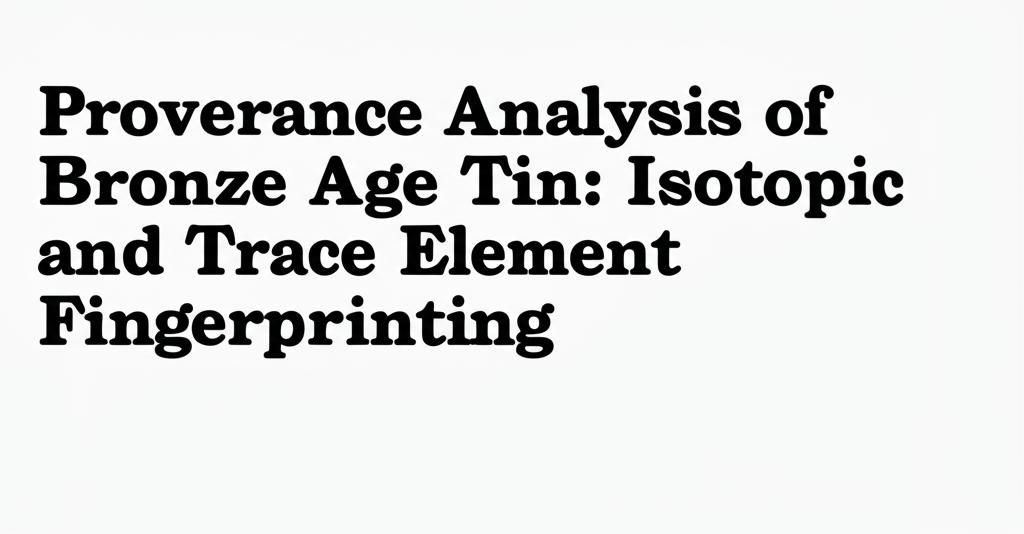The quest to understand the origins of tin, a critical component of Bronze Age bronze, has long been a significant puzzle in archaeology. Recent advancements in isotopic and trace element analysis are shedding new light on this ancient enigma, redrawing the maps of Bronze Age trade networks and revealing the surprising reach of early metal procurement.
The "Tin Problem" and the Power of FingerprintingBronze, an alloy of copper and typically around 10% tin, was revolutionary. It was harder, easier to cast, and had a more appealing golden color than copper alone, leading to its widespread use in tools, weapons, jewelry, and other everyday objects. However, tin deposits are geographically scarce, much rarer than copper. This scarcity has created the "tin problem": how did Bronze Age civilizations, particularly those in regions with no local tin sources like the Eastern Mediterranean and Mesopotamia, acquire this vital metal?
For centuries, archaeologists have debated the sources of this tin. Now, sophisticated scientific techniques are providing more definitive answers. Provenance analysis, specifically employing isotopic and trace element fingerprinting, allows researchers to compare the chemical and isotopic signatures of tin artifacts with those of tin ores from various geological deposits.
Key Analytical TechniquesTwo primary methods are at the forefront of this research:
- Isotopic Analysis: This technique focuses on the ratios of different isotopes (atoms of the same element with different numbers of neutrons) of tin and lead found within tin ores and artifacts. Tin deposits formed at different geological times and under different conditions will have distinct isotopic "fingerprints." Lead isotopes are particularly useful because their ratios can provide a geological model age for the ore deposit.
- Trace Element Analysis: This method measures the concentrations of various trace elements (elements present in very small quantities) within the tin. Different ore sources often have unique combinations and concentrations of these trace elements. Inductively Coupled Plasma Mass Spectrometry (ICP-MS) is a key analytical tool used for its high sensitivity in detecting a wide range of elements.
By combining these two approaches, researchers can create a more robust and reliable fingerprint for tin, helping to narrow down its potential origins.
Recent Discoveries and Shifting PerspectivesRecent studies have yielded significant breakthroughs:
- European Tin in the Eastern Mediterranean: For a long time, Central Asian tin sources were considered a primary supplier for the Eastern Mediterranean. However, research from institutions like Heidelberg University and the Curt Engelhorn Centre for Archaeometry, analyzing tin ingots from sites in Israel, Turkey, and Greece dating to the second millennium BCE, has demonstrated that much of this tin actually originated from European deposits, particularly those in Cornwall and Devon (Great Britain).
- British Tin's Dominant Role: A very recent study published in Antiquity (May 2025) further solidifies the importance of British tin. By applying a novel combination of trace element, lead isotope, and tin isotope analyses to tin ores and artifacts from Western and Central Europe, as well as tin ingots from Bronze Age and Early Iron Age shipwrecks in the Mediterranean (off the coasts of Israel and southern France), researchers have demonstrated that these ingots can be provenanced to ores in south-west Britain. This suggests that the rich and accessible tin deposits in Cornwall and Devon played a fundamental role in the widespread adoption of tin-bronze metallurgy across Europe and the Mediterranean during the second millennium BC. This implies that small farming communities in Britain were mining and trading tin over vast distances, reaching major Bronze Age civilizations.
- Understanding Trade Routes: These findings are reshaping our understanding of Bronze Age trade networks. The presence of British tin in the Eastern Mediterranean points to complex and far-reaching trade routes that spanned thousands of kilometers, connecting disparate cultures and economies earlier than previously thought. These routes likely involved both sea and land transport, possibly through France via river valleys.
- Refining Analytical Methods: Ongoing research also focuses on refining the analytical techniques themselves. For example, understanding how smelting processes might alter the isotopic or trace element composition of tin is crucial for accurate provenance. Researchers are conducting smelting experiments to account for potential fractionation (changes in isotopic ratios) during metallurgical processes.
- Central Asian Sources Re-evaluated: While European sources, particularly British tin, appear to have been major players, especially in later Bronze Age Mediterranean contexts, the role of Central Asian tin deposits (e.g., in modern-day Tajikistan, Uzbekistan, and Afghanistan) is also being clarified. Some studies suggest these sources were significant, particularly for Central Asian Bronze Age cultures like the Andronovo and the Bactria-Margiana Archaeological Complex (BMAC), and potentially supplied early bronzes in the Near East. The Uluburun shipwreck (c. 1300 BC) off the coast of Turkey, with its substantial cargo of tin ingots, remains a key site for this debate, with different studies suggesting origins in either Central Asia or Europe (including Britain).
Despite these advances, challenges remain:
- Overlapping Signatures: The isotopic and trace element signatures of some ore deposits can overlap, making definitive attribution difficult in certain cases.
- Limited Ore Data: Comprehensive databases of the chemical and isotopic compositions of all potential Bronze Age tin sources are still being compiled.
- Recycling and Mixing: Bronze was often recycled, meaning artifacts might contain tin from multiple original sources, complicating provenance analysis.
Future research will continue to expand the database of ore signatures, further refine analytical methodologies to address issues like smelting-induced fractionation, and analyze a wider range of artifacts from diverse geographical locations and time periods. The integration of archaeological evidence, textual sources (where available), and scientific data will be key to painting an ever-clearer picture of the vast and intricate networks that supplied the Bronze Age world with the tin that defined an era. The ongoing analysis of tin ingots from shipwrecks continues to be particularly valuable as they represent direct evidence of traded raw materials.
The "tin problem" is gradually being solved, revealing a Bronze Age world more interconnected and dynamic than previously imagined, with materials like tin serving as crucial drivers of early international trade and technological advancement.

